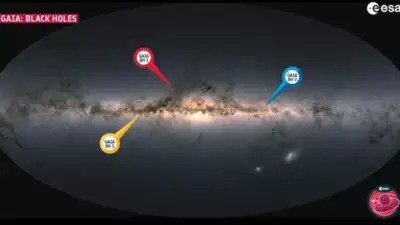
Gaia-BH3

18.04.2024
Gaia-BH3
|
For Prelims: About Gaia-BH3, Stellar black hole vs. Super massive black hole |
Why in the news?
Recently, astronomers spotted the most massive known stellar black hole in the Milky Way galaxy named Gaia-BH3.
About Gaia-BH3:
- It is the most massive stellar black hole yet discovered in the Milky Way galaxy. It was spotted in data from the European Space Agency’s Gaia mission because it imposes an odd ‘wobbling’ motion on the companion star orbiting it.
- The researchers used the European Southern Observatory’s Very Large Telescope in Chile’s Atacama Desert and other ground-based observatories to confirm the mass of Gaia BH3.
- It has a mass that is nearly 33 times that of our sun, and it’s located 1,926 light-years away in the Aquila constellation, making it the second-closest known black hole to Earth.
- The closest black hole is Gaia BH1, which is located about 1,500 light-years away and has a mass that is nearly 10 times that of our sun.
- Most Massive Black Hole in Milky Way galaxy: The title for the most massive black hole in our galaxy will always belong to Sagittarius A*, the super massive black hole located at the center of the Milky Way, which has about 4 million times the mass of the sun, but that is because it’s a super massive black hole, rather than a stellar black hole.
Stellar black hole vs. Super massive black hole:
- Stellar-mass black holes are formed from the gravitational collapse of a single star or from the merger of two neutron stars. Therefore, they have masses similar to the masses of stars.
○More specifically, stellar-mass black holes have masses ranging from about 3 times the mass of our sun to about 50 times the mass of our sun.
- In contrast, super massive black holes have a mass greater than about 50,000 times the mass of our sun and are typically millions to billions of times the mass of our sun.
○They are far too large to have formed from the gravitational collapse of a single star. However, scientists do not currently know how they form.
- Super massive black holes are always found at the center of a galaxy and almost all galaxies have a super massive black hole at its center. This seems to suggest that each super massive black hole is formed as part of the formation of its galaxy.
Source: The times of India